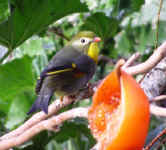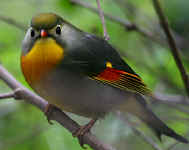|
 |
BREEDS & their NEEDS
PEKIN
ROBIN
Leiothrix lutea
|
 |
GENERAL INFORMATION :
- Common Name/s: PEKIN ROBIN, RED BILLED
LEIOTHRIX.
- The Pekin Robin is not a "Robin".
- Origin / Distribution: From the Himalayas to China.
- Status In Wild:
Has CITES Appendix II listing.
- Age To Sexual Maturity: ?
- Sexing: (Similar but visual sexing is possible)
- Colour mutations: None
- Temperament:
- Has a pleasant song,
- they are inquisitive birds and will become fairly tame and take food
from the breeders hand.
- The attractive plumage (see picture above) has made the Pekin
Robin a sought after bird both for the bird breeders as well as a pet.
DESCRIPTION :
- The yellow throat and yellow-orange chest are much brighter in males
- whilst females lack the red patch on the primaries.
- Tail coverts are red in males and orange-buff in females.
- Care needs to be taken when using primaries for sexing, as different sub-species
have varying amounts present.
- Likewise some races are brighter in overall body colouration than others.
- If choosing a pair of birds, pick the two extremes :
- – in theory, the brightest should be a male, likewise, the
dullest a female.
- Another theory indicates that males have a redder beak and pale
legs
- while females have dark legs and a paler beak.
- The Pekin Robin loves to preen and be preened.
SONG :
-
Pekins are renowned songsters and it is the vocalisation
of the male
-
So much so that one Breeder, who seemed to be able to
imitate the call of a female, states that he could sex young as early as two
or three weeks of age by this means.
-
It seems extremely early and I would welcome confirmation
of this from other breeders if possible?
-
The call of the female is a simple two-syllable whistle
repeated up to five times.
-
That of the male has been described variously as
tee-tee-tee-tee-tee-tee…
-
According to the above Breeder, "calling-females"
will illicit a response from both sexes if they are separated, thus enabling
sexing.
HOUSING:
- The Pekin Robin prefers a well planted aviary.
- Only one pair per aviary.
- They do not like to be on their
own
- If more than one cock bird is in the same aviary, the cock birds can
become aggressive to each
other during the breeding season.
- Pekin Robins like to bathe.
- This helps these birds keep their plumage in top condition.
Diet / Feeding:
- The Pekin Robin is a "Softbill"
- The name "Softbill" refers to their diet not their beak.
- Softbills feed on soft foods such as insects and plant materials and rely
less on hard seeds.
- They eat foods like fruit, insects and nectars.
- If a variety of Softbills are housed in one aviary, care must be taken to
satisfy the needs of
each type of Softbill.
- Separate feed stations should be provided.
- They will keep the Aviary free of
ants, earwigs, flies, moths and even spiders. (They only tend to
eat the spiders' body tho' and leave the legs in a gruesome pile
on the floor.)
- The Pekin Robin requires a
good quality finch mix
- Basic Finch seed mix should include
: Canary seed, White French Millet,
Japanese Millet,
Yellow and Red Panicum millet.
- Seeding grasses
- some fruits (e.g. apple, figs), some berries and some leafy green
vegetables can be offered.
- Sprouted or soaked seed if available.
- Live food is essential especially at breeding season.
- Mealworms, crickets, small commercially bred cockroaches and small
locusts are ideal.
- Insects form the majority of its food intake.
NESTING:
Nesting receptacles:
- In the Wild :
- They will build a nest in a shrub or dry brush.
- In Captivity :
- they will use a wooden nest box with the top half of the front
removed.
NEST:
- The Pekin Robin will build a cup shaped nest out of grasses, twigs,
mosses, short pieces of teased hessian and other materials.
- Nest is lined with feathers, soft materials and soft fine grasses.
- May use a half open nest box.
- If a nest box is to be used, the box should be placed in a concealed
place preferably behind some shrubbery to provide some privacy for the
birds.
WHO INCUBATES THE
EGGS:
- Adequate spare nest receptacles must be available for pairs nesting in
artificial nests before the current clutch leave the nest.
- Adequate new nest material must be available for the birds to rebuild the
old nest or build a new nest for the next clutch.
- Cocks are highly territorial once
nesting begins.
BREEDING:
- Egg Colour
: White with orange /brown spots on the larger end.
- Clutches per year
: 2 - 3.
- Eggs per nest
: 3 - 4.
- Incubation
: approx. 12-14 days.
- Fledge
: approx. 12 - 14 days.
- Independent
: approx. another 3 - 4 weeks.
- Pekin Robin breeding pairs can be offered soft-bill rearing foods.
- They usually moult in autumn.
- Young should be removed from the parent birds as soon as they are fully
independent so as to avoid possible aggression from a parent.
HAND-REARING MIX
(If you are ever in the unfortunate position that you have to save a
chick by Handrearing)
- Dried fruit-rearing mix with
egg-food mixed with warm water to a runny consistency
- Depending
on age feed: tiny babies every 2 hours thru the day and
poss less during the night
- Lessening frequency with age,
growth etc.,
- Keep warm.
- See page on
hand-rearing for further Tips.
SEXING IMMATURE YOUNGSTERS :
-
Chicks can be sexed at about a week old, just as the tail
coverts begin to show
-
– males are rusty red,
-
while those of the female are buff.
-
young can be sexed around 6-8 weeks, presumably by
the same method.
-
Sexing presents no problem with this species, if this
method is used.
|